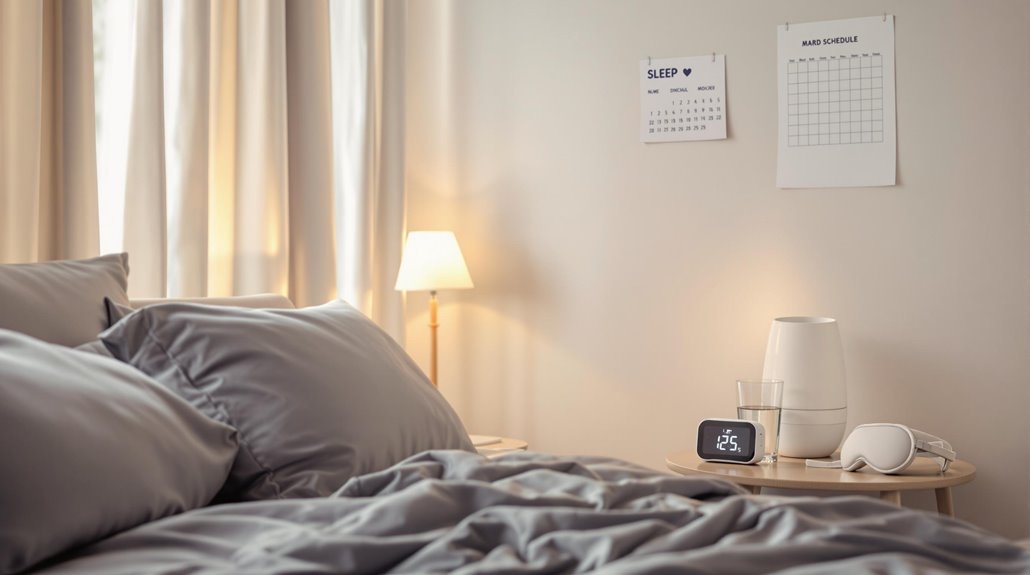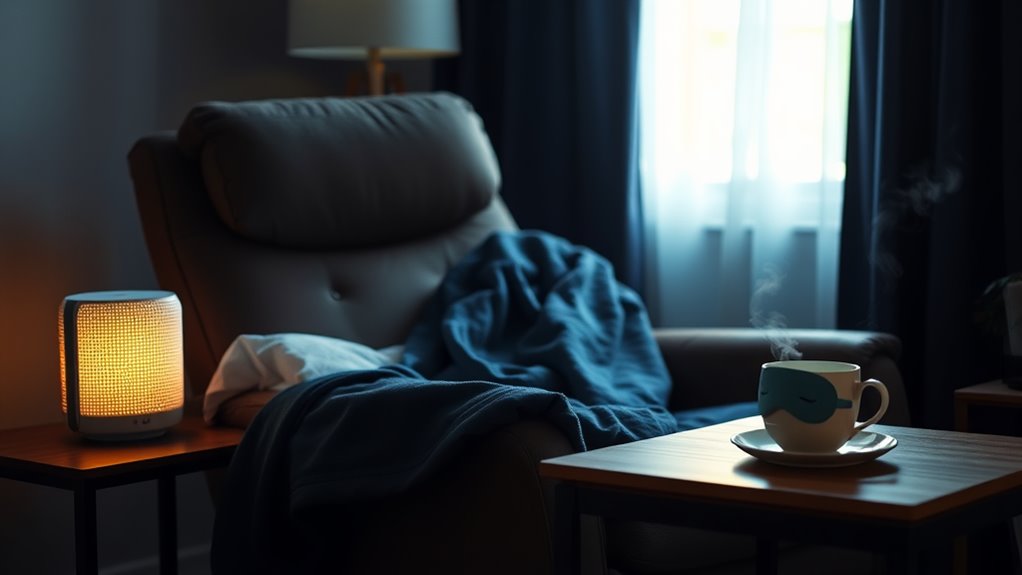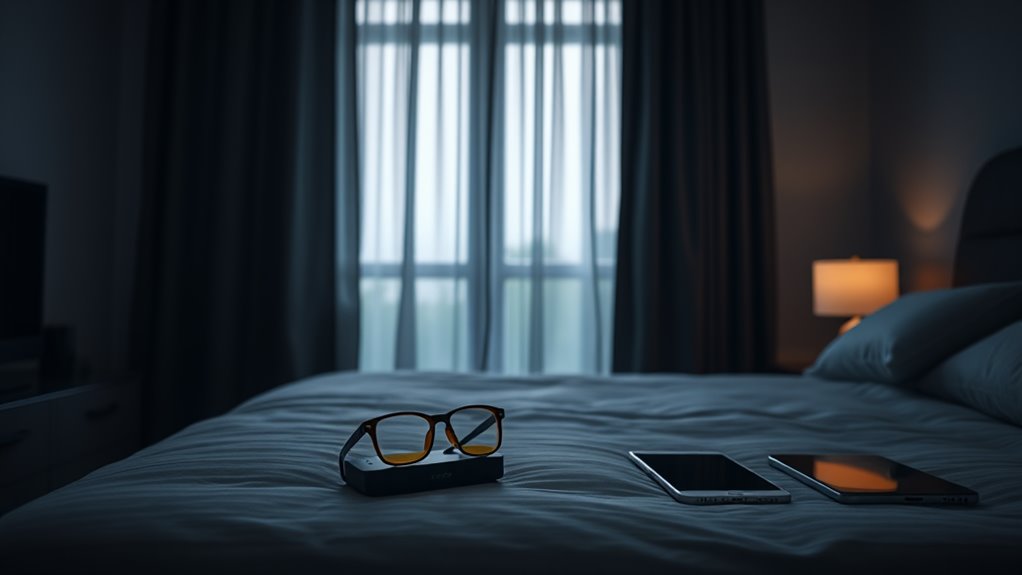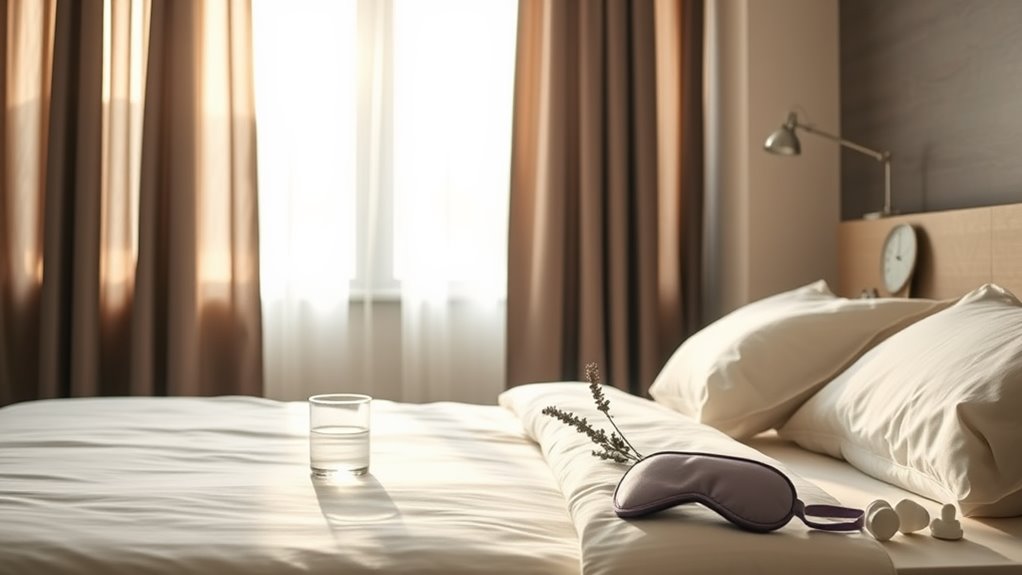
As a shift worker, improving your sleep starts with establishing a consistent sleep schedule, even on days off. Create an ideal sleep environment that’s dark, cool, and quiet using blackout curtains and earplugs. Take strategic naps and manage caffeine intake carefully. Practice relaxation techniques like mindfulness or aromatherapy before bed. Limit exposure to blue light by wearing special glasses or enabling device filters. Enjoy balanced meals and regular physical activity to support your body’s rhythms. Seek professional guidance if needed. With these practices, you can greatly enhance your sleep quality and maybe discover even more effective methods.
Consistent Sleep Schedule
Keeping a consistent sleep schedule is essential for shift workers who often grapple with irregular hours. Embracing such consistency can be your pathway to freedom from the shackles of fatigue and cognitive fog. The chaos of shift work doesn’t have to dominate your life. By stabilizing your sleep cycle, you can enjoy better rest quality and a sharper mind. Balance your body’s clock even amid the turbulent seas of changing shifts, and watch as your energy and well-being soar. To harmonize your sleep cycle, craft a sleep schedule aligning with your work roster. Aim for 7-9 hours of rest within each 24-hour span, regardless of the shifting day or night. By establishing a bedtime routine, you can promote better sleep hygiene, which is fundamental for overall emotional regulation and stress resilience. To further optimize your sleep environment, ensure the sleep area is dark and quiet, minimizing disturbances that could otherwise disrupt your much-needed rest. Anchor your sleep and wake times to the same slots each day, including off-days. This commitment enhances your body’s shift adaptation, empowering you to face life’s demands with vigor. Communicate and set expectations with loved ones about your sleep needs, enlisting their support. Strategically plan naps without overshadowing your core sleep period, and you’ll achieve peak alertness. Be liberated by the knowledge that a consistent sleep schedule can fortify your health, freeing you from the toll of irregular shifts.
Ideal Sleep Environment
As you work towards maintaining a consistent sleep schedule, it’s equally important to create an ideal sleep environment that supports your rest.
Sleep essentials include crafting a space that’s dark, quiet, and cool. Block out as much light as possible with blackout curtains or an eye mask, as a dark environment is vital for peak sleep quality. Silence unwanted noise with earplugs or a white noise machine to create a tranquil atmosphere. Additionally, silence electronic devices like phones to prevent disturbances. Shift work sleep disorder disrupts circadian rhythms, which makes minimizing these disturbances even more crucial. White noise features consistent amplitude across all frequencies, resembling the sound of TV static, helping mask disruptive sounds that might interfere with sleep.
Environmental factors, such as room temperature and ventilation, play a significant role in your sleep sanctuary. Keep your room cool, ideally between 16-20°C (60-68°F), and make certain it’s well-ventilated to maintain a consistent and comfortable climate.
Your bedding should also invite relaxation, so choose materials that promote comfort and contribute to restful sleep.
Limit bright light exposure as bedtime approaches. Dim screens and employ light-blocking window treatments to shield your space from disruptive light.
Effective Napping Tactics

Napping can be a powerful tool for shift workers seeking to maintain alertness and optimize performance. Knowing the right nap duration and timing can set you free from fatigue. For a night shift, consider napping 1.5 to 3 hours beforehand to enhance your alertness. A sweet spot is often a 2.5-hour nap, but even a quick 30-minute snooze can boost your performance. Combine this with caffeine timing; consuming caffeine right after a nap at the start of your shift can further elevate your alertness. A brief walk before your shift can also help maximize Non-Exercise Activity Thermogenesis throughout the day, which aids in maintaining energy levels. During long shifts, mid-shift naps become your ally. For an 8-hour stretch, a 30-minute nap can keep you on your toes. Should your shift stretch beyond 12 hours, aim for a 2 to 3-hour nap to fight off fatigue. Consistent sleep patterns can mitigate the cognitive impairments that are common among shift workers, making regular napping part of an effective sleep strategy.
Smart Light Management
Smart light management offers a transformative approach to enhancing the sleep quality and overall well-being of shift workers. Leveraging adaptive lighting, you can align your environment with natural daylight patterns, helping your body’s internal clock stay in tune amidst unconventional hours. This isn’t just about adjusting brightness; it’s about embracing a lifestyle that promotes better health and energy. You’ll experience improved sleep hygiene as this technology mimics the sun’s cycle, reducing melatonin suppression and the risk of sleep disorders. Nutrients like Vitamin C from fruits and vegetables can also play a role in supporting your body’s natural rhythms and enhancing the benefits of adaptive lighting.
Energy efficiency is another liberating aspect of smart lighting. Automatic light adjustments tailored to your activity not only conserve energy but also guarantee your workspace is always ideal, boosting alertness and reducing fatigue. Additionally, the use of Lightcloud Technology can simplify the installation process for users, supporting remote management of lighting systems for enhanced convenience.
Imagine working in a place where lighting dynamically caters to your needs—an empowering setup for peak productivity. By customizing lighting scenarios through mobile apps or web-based dashboards, you direct your comfort and efficiency effortlessly. Incorporating smart lighting into your daily routine can enhance workplace comfort, elevate mood, and increase satisfaction. It supports your aim for a balanced, healthy lifestyle—freeing you from the constraints of traditional lighting setups and helping you succeed in a demanding world.
Mindful Substance Intake

Many shift workers underestimate the impact of their substance intake on sleep quality. It’s easy to overlook how caffeine, alcohol, nicotine, and even some medications shape your ability to rest well. But managing them mindfully can liberate you from restless nights.
1. Caffeine Timing: To maintain your alertness without sacrificing sleep, limit caffeine to the beginning of your shift.
Consume it in moderation every 1-2 hours rather than all at once, and definitely steer clear 3-4 hours before sleep. This rhythm helps you stay awake when you need it and guarantees your body is ready to relax later.
2. Alcohol Effects: While a drink might seem like a shortcut to slumber, alcohol hinders restful sleep.
Avoid consuming alcohol within three hours of bedtime to prevent fragmented and less restorative sleep. Liberate yourself from its long-term sleep disruptions by moderating your intake.
3. Nicotine Impact: Nicotine and other stimulants can sabotage your sleep plans.
Avoid these hours before sleeping, as they make falling asleep harder and deteriorate sleep quality. Recognize the power of stimulant awareness in reclaiming your rest, and consult your healthcare provider regarding medication management to adjust any interference with your sleep cycle. Adequate hydration supports overall wellbeing, and managing your water intake alongside substances aids in maintaining a balance that promotes better sleep.
Balanced Meal Timing
When you’re working shifts, structuring your meals can greatly influence your energy levels and overall well-being. It’s liberating to craft a meal preparation plan that aligns with your individual rhythm, rather than fighting against it.
Eating every 2-3 hours is key for maintaining steady energy, but if snacking isn’t feasible, three balanced meals can suffice. Keep portable snacks handy to power you through unexpected energy slumps. On night shifts, mimic daytime schedules as much as possible and focus on nutrient timing—eating lighter meals between midnight and 6 AM respects your gut’s natural rest period.
Daytime meal habits are your allies against health risks tied to shift work. Eating meals dense in complex carbs, proteins, and fiber helps align your body’s clocks, reducing risks of glucose spikes and chronic health issues like diabetes.
Prepping meals in advance can be your secret weapon for tackling irregular schedules and won’t bind you to restricted eating hours. Plan your meals for ease and satisfaction—opt for foods that are gentle on your digestive system, avoiding late-night indulgences high in fat or sugar.
You’re not just fueling your body; you’re empowering your health and freedom.
Regular Physical Activity

A shift worker’s routine can be a formidable obstacle when it comes to maintaining regular physical activity. Yet, with the right exercise routines, you can overcome challenges and embrace physical wellness.
The benefits of breaking the cycle are tremendous: improved sleep, reduced health risks, and heightened mental clarity. Imagine sleeping better and feeling alive—even after grueling shifts. Regular physical activity does this by regulating your sleep cycles, balancing energy, and keeping chronic diseases at bay.
So, how can you make exercise a part of your life?
- Schedule workouts before shifts: Start with an invigorating session to energize your day. It sets a positive tone for the hours ahead.
- Use flexible workout options: On-demand workouts and short, high-intensity sessions tailor your routine to your unique rhythm.
- Choose activities matching energy levels: On low-energy days, perhaps yoga or a brisk walk; on energetic days, weightlifting or running works wonders.
Relaxation Techniques
Finding effective relaxation techniques is essential for shift workers working towards better sleep. You deserve the kind of rest that rejuvenates your mind and body, releasing a sense of freedom in your waking hours.
Start with mindfulness breathing exercises—embrace diaphragmatic breathing to release built-up stress. A simple body scan can connect you to the present moment, letting your worries drift away. Pair these practices with deep breathing exercises, setting the stage for restful slumber.
Engage in calming activities before bedtime. Feel the tension dissolve in a warm bath or immerse yourself in the pages of an enchanting book. Journaling can also be a therapeutic outlet, allowing you to unburden your mind onto paper.
Consider avoiding strenuous activities and screens during this time—they can overstimulate when your goal is calm.
Incorporate aromatherapy relaxation to enhance your wind-down routine. Scents like lavender or chamomile can soothe your senses, encouraging relaxation and facilitating deeper sleep.
Blue-Light Management

Understanding and managing blue light exposure is essential for maintaining good sleep hygiene, especially for shift workers. Blue light, that high-energy glow from screens and the sun, can disrupt your sleep by suppressing melatonin. It’s hard to shake off, but embracing a digital detox could be your shield.
Here’s how you can conquer blue light and reclaim your rest:
- Gear Up with The Right Glasses: Invest in blue light blocking glasses. They filter out that pesky 460-480nm spectrum, freeing your eyes and inviting better sleep. Slide them on during your shifts and your brain will thank you.
- Transform Your Gadgets: Apply blue light screen protectors to your devices. While you’re at it, enable blue light filtering features on your smartphones and dim your monitor’s brightness. This proactive armor fights off those sleep-depriving rays.
- Set the Right Mood: Make your environment sleep-friendly. Swap out blinding white lights for calming red nightlights. If you can, steer clear of screens entirely before bed. A little distance can go a long way in enhancing your sleep quality.
Embrace these changes, release yourself from blue light’s grip, and your sleep—and wellbeing—will flourish.
Professional Sleep Guidance
While managing blue light exposure helps, embracing professional sleep guidance will equip you with a thorough strategy for improved rest.
As a shift worker, combatting shift fatigue can feel like a constant battle, but assistance is at your fingertips. Sleep apps offer personalized recommendations to sharpen your sleep routine and conquer this challenge. These digital tools can remind you when it’s time to wind down, adjust alarms to perfect your nap timing, and even analyze your sleep cycles to guarantee you’re empowered with insightful data.
In addition to apps, consulting a sleep specialist can elevate your approach, providing clarity on the best practices tailored specifically for you. They’ll guide you through schedule adjustments that sync with your shift rotations. The goal is liberation from the clutches of poor sleep, allowing you to shine at work and in life.
Consider professional advice on creating a sleep-conducive environment, employing tactics like sun-blocking shades or sound machines, essential for high-quality rest.
This guidance will help you navigate the complexities of shift work, nudging you towards balance and rejuvenation. You’ll find yourself more alert and ready to face the world, reducing the grip of fatigue on your daily adventures.
Prioritize Consistent Sleep Patterns

Establishing and maintaining consistent sleep patterns is paramount for shift workers to guarantee ideal rest and well-being. Considering the challenges posed by irregular work hours and varying shift demands, adopting tailored strategies can greatly improve sleep quality and overall health. By aligning sleep schedules with work shifts and creating a conducive sleep environment, shift workers can mitigate the negative impacts of sleep disruption.
Consistent scheduling is the cornerstone of effective sleep hygiene for shift workers. By adhering to fixed bedtimes for each shift type and making gradual adjustments to sleep routines when changes occur, individuals can minimize disruptions and enjoy restorative sleep.
Balancing work and leisure effectively requires planning and adaptation. Strategies such as using blackout curtains or white noise machines, engaging in relaxing pre-sleep routines, and discussing potential schedule modifications with supervisors can make a considerable difference.
In fostering a sleep-friendly environment, shift workers should focus on maintaining a dark, quiet, and cool bedroom. Mitigating light and noise distractions, and creating a bedtime routine that promotes relaxation, helps signal the body when it’s time to wind down.
As work schedules shift, workers can benefit from rotating shifts in a natural progression and adopting a split-nap strategy to bridge lengthy hours between shifts.
The essence of successful sleep hygiene for shift workers lies in recognizing individual needs and adjusting lifestyle habits accordingly. While the nature of shift work presents unique challenges, being proactive in managing sleep patterns can greatly enhance quality of life.
Prioritizing sleep, guaranteeing consistent rest, and adapting to shift changes with informed strategies can transform the shift work experience into a balanced and health-promoting routine.














